|
|
Sir Gallahad

|
|
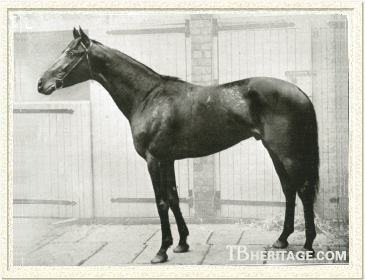 |
|
|
Steamships were the favored modes of trans-Atlantic travel during the
early years of the 20th Century, and the Atlantic Transport Line's
S.S. Minnetonka and S. S. Minnehaha provided posh accomodations for
their human passengers, as well as many notable thoroughbreds who
made the crossing. World War I caused a break in that service
as both ships were sunk by U-boats, the Minnehaha going down in 1917
carrying the stallion Maiden Erlegh, recently purchased for $80,000
at the Newmarket Sales; and the Minnetonka sunk as a war transport in
1918. The Minnetonka II was commissioned in 1924 and in
December of 1925, left London for New York carrying a cargo that was
to prove more precious than most, the thoroughbred stallion Sir
Gallahad.
Sir Gallahad was a landmark in more than one regard. Not only
was he purchased by the first modern stallion "syndicate,"
but he became the sire that put Arthur Hancock's Claiborne Farm on
the map as a home to world class stallions. And although it was
not known at the time, his sire and dam were to prove a pair of the
most influential thoroughbreds of the century, and Sir Gallahad
himself, one of the most important sires, and sire of broodmares in
America.
Sir Gallahad was foaled at Haras de Fitz-James in France, where his
breeder, Jefferson Davis Cohn, headquartered his stock at the time,
including the stallion Teddy. Stallions and broodmares were
later moved to Haras du Bois-Roussel (the 19th century stud of Henri Delamarre), which Cohn retained the lease on until the mid-1930s, when he sold the entire stud to Leon Volterra.
Sir Gallahad was from the third crop by Teddy, who had also sired Plucky Liege's first foal, stakes-placed Marguerite de Valois (1919), in his premier season at stud. Plucky Liege was bred by Lord
Michelham, to whom Cohn served as secretary, and from whom he had
purchased the winning daughter of Spearmint. Plucky Liege was a
major asset to Cohn as a broodmare, producing stakes winners Poule
d'Essai des Poulains (French 2,000 Guineas) winner Sir Gallahad (c.
1920 by Teddy), Bull Dog (c. 1927 by Teddy), Quatre Bras (c. 1928 by
Teddy), Grand Prix de Paris winner Admiral Drake (c. 1931 by Craig An
Eran), Bel Aethel (c. 1933 by Aethelstan), and Derby winner Bois Roussel (c. 1935 by Vatout). The latter was bred by Leon
Volterra; Plucky Liege being in foal to Vatout at the time Cohn sold
his stud.
Sir Gallahd on the Turf
As a 2-year-old, Sir Gallahad started 5 times, and won 3 of
them. Although he trained impressively for conditioner Robert
Denman, he was unplaced in his debut in the Prix de Villers at
Deauville while starting as favorite. The only horse he beat in
the field of 6 was a colt named Massine, who became one of the best
colts over a distance in that bumper French crop. Sir Gallahad
was fifth of 5 in his next outing, the Prix de St. Gatien, also at
Deauville. In his third start, taken back in distance from 5
furlongs to 4 and a half furlongs in the Prix de la Mediterranee at
Saint-Cloud, Sir Gallahad won by 2 lengths in a field of 27 at high
odds, raising the suspicion that his earlier performances were just
drama setting up for a betting coup to cash out in this third
race.
Now, either the cat was out of the bag, or the colt had finally
figured it out, because in his next start, the Prix du Petit-Couvert,
Sir Gallahad won again, by 3 lengths when moving back to 5 furlongs
at Longchamp. In his final race of the season, the Prix Eclipse
at 6 and a half furlongs at Saint-Cloud, he won by a length on an
adverse race course. He was not considered even close to
the juvenile champion in France that year, the mighty Epinard, or
other good 2-year-olds Niceas and Mackenzie.
At 3, Sir Gallahad opened his season in April with a win over Niceas
in the Prix Edgard de la Charme (10 f. Saint-Cloud), followed up with
another victory in the Prix Daphnis (8f. Maisons-Laffitte) in a short
field of 3, and made it 3 in a row with a win in the classic mile
Poule d'Essai des Poulains, beating Niceas again. In the Prix
Lupin (9f.), won by an improving Massine, Sir Gallahad faded to
fifth, unable to stay the mile and 5/16ths. In the Prix du
Jockey Club (12f. Longchamp), however, Cohn's Teddy colt ran
gallantly into third behind Le Capucin and Niceas, losing by only 2
necks.
Next out in the Grand Prix de Paris (15f. Longchamp), temperament
issues were raised when, after a rough start, Sir Gallahad dumped his
rider, ran off and leapt into a body of water rather than
compete. In the Prix du Président de la République (13f.
Saint-Cloud) he failed utterly to stay and was last of 10
starters.
Having pounded the point home, Sir Gallahad's handlers returned him
to his favored shorter trip, and he ran second to Niceas in the Prix
des Marettes (6f. Deauville), then reversed the decision by beating
Niceas in the Prix Jacques Le Marois, also at Deauville, at a mile.
Pushed to his limits in the Prix Royal Oak (15f. Longchamp), Sir
Gallahad managed to run a surprising second, 4 lengths behind
Filibert de Savoie. In the 10 furlongs La Coup at
Maisons-Laffitte, Sir Gallahad was out of his league and ran last
behind the winner, Scopas. In his final 2 starts of the year,
he was second in the Pix de la Forêt (7f.) to Scaramouche, then third
to Heldifann in the Prix du Petit-Couvert (5f.).
Sir Gallahad began his 4-year-old season in England, in the
Lincolnshire Handicap at Doncaster. He went off as one of the
lightweights at 117 pounds and romped home 3 lengths on top going his
favored mile distance at high odds. Returned to France, he was
third in the Prix des Sablons (10f. Longchamp), beaten by Massine and
St. Hubert. Next out, Sir Gallahad won the Prix Boïard over the
same mile and a quarter distance at Saint-Cloud over Le Capucin by 3
lengths in deep going.; In the Prix Daphnis (9f.
Maisons-Laffitte) he won as he pleased by 5 lengths, taking that race
for the second consecutive running. He pulled a simlar
performance with a back-to-back win in the Prix Edgard de la Charme
(10f.).
Sir Gallahad had now gained a reputation to rival that of Epinard,
who had been the French "wonder horse" of his period.
A match race was set at 6 1/2 furlongs at Saint-Cloud, and Sir
Gallahad won by a short neck over Epinard, who had been handicapped
by a flare-up of chronic foot soreness. Sir Gallahad made
one final start, in the Prix du Gros Chene (5f. Chantilly) but went
down to Niceas and retired with 11 wins in 24 starts. His
record showed that on a good day, at shorter distances, Sir Gallahad
was very good indeed, but he threw in the occasional clinker; and was
clearly out of his element at the longer staying tests - he never won
beyond a mile and a quarter.
After their match race, Epinard was sent to the U.S. to race and
earned fame and praise in a series of "international"
special events, even though he could not win under American
conditions. He entered stud in 1925 at Dixiana Stud in Kentucky
with much acclaim. Arthur Hancock, who owned Ellerslie Stud and
had married into ownership of Claiborne Farm in Kentucky, recognized
that Sir Gallahad, having beaten Epinard, might also be a highly
desirable stud prospect.
Sir Gallahad in the Stud
Hancock liked to be on the leading edge of bloodline trends, and at
the time, Teddy was becoming a dominant force in European
breeding. Sir Gallahad led him to his first and only sire
championship in 1923, although he was a perennial leading sire.
After standing Sir Gallahad for the 1925 season at Haras du Bois
Roussel, owner J.D. Cohn was approached by Hancock, who made a
substantial offer to purchase the young stallion on behalf of a
syndicate composed of Hancock hmself, also Franco-file William
Woodward Sr., and breeders R.A. Fairbairn, and Marshall Field. The
price was a hefty $125,000, and since Cohn still had the sire Teddy, and the dam, Plucky Liege, the deal was easily done. This was the prototype of American stallion syndications, throwing together really big money and paving the way for the purchase of proven
stallions like Blenheim II and Nasrullah.
So Sir Gallahad came to America on the S.S. Minnetonka and stood his
first American season at Claiborne Farm in 1926. A big,
handsome, eye-filling horse at 16.1 hands, the bay with a star and
snip was hard to flaw. Although he had a stayer's pedigree with
Teddy on Spearmint, he represented a turning point in French
breeding, away from the lanky, leggy stayer and more toward the
miler/speed model that America came to embrace. He was lengthy
and well muscled, with a good shoulder and had a big, prominent
hip. He was also very sound, with good legs and feet, and a
good temperament. Oddly, although he got a lot of good
2-year-olds, his influence in North America tended more toward middle
distance ability and stamina, compared to his full brother Bull Dog
who arrived in late 1930 and dominated with an even more precocious
sprint model. Sir Gallahad was a great breeding horse and
fertile right up to the end, siring his last crop when 28 years old,
and dying the next year in 1949.
Sir Gallahad's first crop, French-bred foals of 1926, produced
nothing of note but the stakes winner LION HEARTED, out of the good
racemare Guerriere (by Verwood), but he may not have been getting the
choicest of Cohn's mares, playing second to his own sire
Teddy.
In the U.S., however, Sir Gallahad thrived, and in all, sired 567
foals in his long and vigorous stud career, with a remarkable 64
stakes winners. He was the Leading Sire in the U.S. in 1930,
1933, 1934 and 1940, and the Leading Broodmare Sire a dozen
times.
|
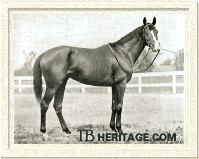
Gallant Fox
| |
Sir Gallahad's kickoff American crop starred one of American racing's
legends, the great GALLANT FOX (b.c. 1927 out of Marguerite by
Celt). Bred by William Woodward's Belair Stud, he was a good
2-year-old but well behind division champion Whichone. Gallant
Fox won the Flash Stakes and Junior Champion Stakes, second in the
United Stakes Hotel Stakes and third in the Futurity. At 3,
"the Fox of Belair" earned his greatness, winning all the
major 3-year-old events but one. His wins included the Wood
Memorial; the Kentucky Derby, Preakness and Belmont Stakes, a series
of races just starting to be recognized as the American Triple Crown;
also the Dwyer Stakes, Lawrence Realization, Arlington Classic,
Jockey Club Gold Cup and Saratoga Cup. His defeat the Travers
Stakes to Jim Dandy is now the stuff of racing lore.
|
Gallant Fox retired to stud at Claiborne and was initially a great
success, getting Triple Crown winner Omaha in his first crop, and
Omaha's brother Flares (Ascot Gold Cup winner) and Horse of the Year
and Belmont Stakes winner Granville in his second. In all he
sired 19 stakes winners from 321 foals, with his additional good ones
including Gangway, Calumet Dick, Wise Fox and Perifox.
Being an out-and-out stayer, Omaha wasn't much of a sire, either,
with only 7 stakes winners, led by the gelding Prevaricator.
Omaha got 2 useful daughters, Flaming Top (dam of champion
Doubledogdare, granddam of Flaming Page, third dam of Nijinsky II and
fourth dam of The Minstrel) and Miss Zibby (dam of Summer Tan).
Flares, also a stayer, did a little better, getting Epigram, Chop
Chop (sire of Victoria Park and Ciboulette), Skytracer, and the mare
Shimmer (dam of Nantallah).
Gallant Fox didn't leave many good broodmare daughters, although
Vasthi founded a good family that included Judger, Bicker,
Bailjumper, and Honorable Miss. Other daughters included Hot
Supper (dam of Volcanic, in the pedigree of Affirmed), White Samite
(dam of Reneged), Lady Reynard (granddam of Dan Cupid), Abeyance
(granddam of Wait Awhile), Gilded Wave (third dam of Dahlia),
Abeyance, and Twilight Tryst.
Gallant Fox wasn't Sir Gallahad's only classic winner; he sired 2
other Kentucky Derby winners, Gallahadion and Hoop, Jr.
|
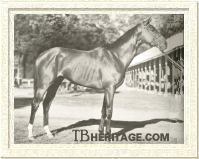
Gallahadion
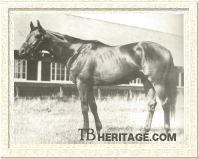
Hoop Jr.
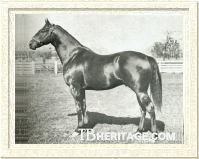
High Quest
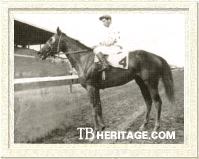
Vagrancy
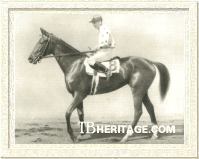
Happy Gal
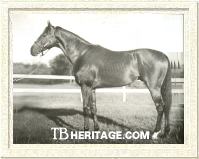
Foxbrough
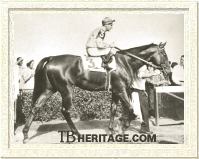
Fighting Fox
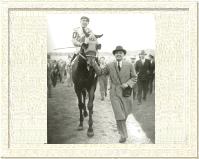
Tintagel with Marshall Field leading him in
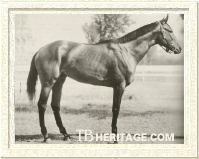
Fenelon
| |
Bred by
original syndicate member Robert A. Fairbairn at his Fairholme
Farm, GALLAHADION (b.c. 1937 out of Countess Time by Reigh Count) was sold
as a yearling to Ethel V. Mars's Milky Way Farm for $5,000. Winner of
the San Vicente Handicap in California, he went to Kentucky to run
second to Bimelech in the Derby Trial, then pulled a huge upset to
beat Bimelech in the Kentucky Derby itself. Those were his
biggest wins, though, as he was third in the Preakness and fifth in
the Belmont (both won by crop champion Bimelech), and second in the
Arlington Classic. At four he was stakes placed and retired to
an insignifcant stud career, siring no stakes winners at all.
HOOP, JR. (b.c. 1942 out of One Hour by *Snob II) was also bred by
Robert A. Fairbairn, selling for a hefty $10,200 as a yearling to Fred
Hooper, making his first sortie into the thoroughbred business.
Stakes-placed at 2, Hoop, Jr. won the Wood Memorial and Kentucky
Derby, and was second in the Preakness Stakes behind Polynesian,
although division champion Fighting Step was a late season
development. (That year actually was dominated by the great filly
Busher.) Hooper retired his Derby winner to stud, first in
Alabama and later in Florida. He was not a great success in either
state, however.
Sir Gallahad also sired a second Preakness winner in HIGH QUEST (b.c.
1931 out of Etoile Filante by Fair Play), who was bred by Marshall
Field, who boarded his stock at Claiborne Farm and sold to Brookmeade
Stable owner Isabel Dodge Sloane for $3,500. At 2, he won the
Eastern Shore Handicap and ran second in the Hopeful Stakes. At
3 he won the Wood Memorial, Preakness Stakes and was 6 lengths second
in the Belmont Stakes behind Peace Chance. At stud he only
sired five stakes winners, the best being Santa Anita Handicap winner
War Knight. His daughter Peroxide became the second dam of the
good runner and sire Native Charger.
Sir Gallahad also sired several top class fillies. William
Woodward's VAGRANCY (b.f. 1939 out of Valkyr by Man O'War) was
stakes-placed at 2, but bloomed into the champion of her crop at 3,
winning the C.C.A. Oaks, Pimlico Oaks, Delaware Oaks, Alabama Stakes,
Gazelle Stakes, and Test Stakes against her own age, and the Beldame
Handicap and Ladies Handicap against older fillies and mares.
Stakes-placed at the highest level at 4, she became a top class
broodmare, dam of 3 stakes winners including St. Leger winner Black
Tarquin, the good filly Vulcania, who also became an important
broodmare. Another daughter, Natasha, also became an major
producer, and her daughter Natashka was Broodmare of the Year in
1981.
Woodward also bred and raced HAPPY GAL (b.f. 1930 out of My Reverie
by Ultimus), who was the Champion 2-year-old filly of 1932, winning
the Saratoga Special, Flash Stakes and Juvenile Stakes, and placing
in 6 other stakes. Unlike Vagrancy, and many other fillies by
Sir Gallahad, Happy Gal was a failure as a broodmare.
Woodward's Belair Stud was also the breeder of Gallant Fox's full
brother FOXBROUGH (b.c. 1936 out of Marguerite by Celt), who was sent
to race in England, where he was the Champion at 2, after victory in
the Middle Park Stakes and Hopeful Stakes. Returned to the U.S., he
became a high class handicapper, taking the Butler Handicap and
Yonkers Handicap at 5. Unfortunately he did nothing at stud.
There was a third full brother to Gallant Fox named FIGHTING FOX
(b.c. 1935 out of Marguerite by Celt). A good 2-year-old, he
won the Grand Union Hotel Stakes and placed third in the Futurity and
Hopeful Stakes. At 3, he won the Wood Memorial, and was third
in the Travers and Whitney Stakes. At 4 he was a top class
handicapper, winning the Massachusetts, Carter, Fleetwing, Jamaica
and Wilmington Handicaps. At 5 he won the Paumonok, the last 2
years showing his tendency to be better sprinting. Fighting Fox
was a useful sire, with 18 stakes winners to his credit, the best of
which were champion Fighting Step, the outstanding handicapper Crafty
Admiral, also Fighting Frank, Bonnie Beryl, Fighting Don and War
Eagle.
Bred by Arthur B. Hancock, TINTAGEL (b.c. 1933 out of Heloise by
Friar Rock) was purchased by Marshall Field, for whom he became the
Champion 2-year-old of 1935 off a win in the Futurity Stakes.
He was also second in the Arlington Futurity. Although he never
won another stakes, at 3, he was a good sprinter at 3, second in the
Paumonok and Hialeah Park Inaugural Handicaps and third in the
Toboggan. Retired at Ellerslie Stud in Virginia, he was not a
success, getting only 4 stakes winners. A daughter, In Love,
produced the good broodmare Hasty Love, dam of champion Hurry to
Market among others.
Marshall Field bred the good filly ESCUTCHEON (b.f. 1927 out of
Affection by Isidor), who won the Alabama Stakes, but became a
seriously important tap root broodmare. She produced 3 stakes
winners: Kentucky Oaks winner Mars Shield, another good filly in
Strange Device, and the colt By Far; and the stakes-placed
Bourtai. Bourtai was the best but no less than 4 of her
daughters became important broodmares. Her family includes
champions Shuvee, Slew o' Gold, Delta and Belmont Stakes winner
Coastal.
Yet another top class winner bred by William Woodward, FENELON (b.c.
1937 out of Filante by Sardanapale) was near the top of his class at
3 and 4. Probably the best staying colt at 3 (Bimelech was the
champion), he won the Travers Stakes, Lawrence Realization, Jockey
Club Gold Cup, and Empire City Handicap. At 4, he won 5 of the
most prestigious handicaps: the Brooklyn, Whitney, Manhattan,
Merchant's and Citizens' and New York. Like many sons of Sir
Gallahad, he was not a good sire, with only 1 stakes winner, the
gelding Magnet.
|
|
Joseph E. Widener had success with Sir Gallahad as well, getting the
speedy colt ROMAN (b.c. 1937 out of Buckup by Buchan). One
of the best of his division at 2, he won the Hyde Park Stakes,
Bashford Manor Stakes and Lafayette Stakes. At 3, he won the
Jerome Handicap, Laurel Stakes and Chicago Handicap, and placed in
the Blue Grass, Bay Shore, and Withers Stakes among others. At 4, he
was a superior sprinter, victorious in the Fall Highweight,
Fleetwing, and American Legion Handicaps, and third in
the Vosburgh.
|
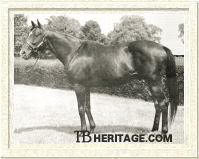
Roman
| |
Roman was more important as a sire, with 54 stakes winners including the 2 Year Old Champion and Preakness Stakes winner Hasty Road, the
Champion 2 Year Old Filly Romanita, and other good ones in Queen
Hopeful, Princess Lygeia, Times Roman, and Roman Line. Several
of his sons did well, mostly as sires of precocious speed like
himself (Catullus, Roman Line, Times Roman) but he excelled as a
broodmare sire, leading that sires list 3 times. His daughters
included Roman Zephyr (dam of Roman Brother), Pocahontas (dam of Tom
Rolfe, Chieftain), Sweet Woman (dam of Sweet Patootie), Desert
Vision(dam of Astray, Desert Love, Desert Law), Islay Mist (dam of
Ole Liz), Roman Gun (dam of Bridle Path), Roman Song (dam of Proudest
Roman and Bravest Roman), Shy Katie (dam of Martins Rullah), Roman
Honey (dam of Honey Jay), Queen Hopeful (dam of Broodmare of the Year
Hasty Queen II), and Nile Lily (second dam of Riverman).
|
Other notables by Sir Gallahad include BLACK DEVIL (Doncaster Cup, in the pedigree of Irish River), INSCO (sire of Lawrin, Unerring,
Inscolassie, Inscoelda), HADAGAL, COUNT GALLAHAD, SIR DAMION, SIR
ANDREW, BOLD IRISHMAN, AMPHITHEATRE, FLYING GAL, and THE SCOUT.
Sir Gallahad sired runners in a range of aptitudes but many of his
best colts had a tendency to stay better than the average
American-bred of the time. As is often the case, stayers don't
make as good sires as speedier types, and few of his sons were good
sires outside of Gallant Fox, Fighting Fox and Roman.
|
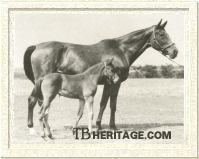
La France
| |
But Sir Gallahad daughters became a rule of their own as broodmares, and he was the Leading Broodmare Sire in the U.S. a dozen
times. His best producing daughters were GALLETTE (dam of
Gallorette, Gallita), LAURA GAL (dam of Challedon), LA FRANCE (dam of
Jacola, Johnstown), VAGRANCY (dam of Black Tarquin), BLACK WAVE (dam
of Jet Pilot), DANCING DORA (dam of Prince Simon), FLYING GAL (dam of
Boswell), FOXY GAL (dam of Helios), BETTY DARE (dam of Iron Maiden,
Judy-Rae), BAYROSE (dam of Pink Velvet), DOUBLE TIME (dam of
Alablue), ESCUTCHEON, DRAWBY, FRAGRANCE, GALLA COLORS, MARGUERY,
MOTTO, NATIVE GAL, OMAYYA, RARE BLOOM, RISK and many others.
|
Sir Gallahad was retired from stud following the 1949 breeding season
at the age of 29. He covered 11 mares in his final year but
nothing of note resulted. He died on the evening of July 8,
1949, found dead in his paddock. Although there is a stone
marker for him in the Claiborne Stallion Cemetery, he does not rest
there. He was buried on a special site at Claiborne's Marchmont Farm
division, next to Gallant Fox's dam Marguerite.
Sir Gallahad was one of the most important sires of the 20th Century
in the U.S., and was the first in a trend of wealthy investors
forming syndicates to acquire outstanding stallions and stallion
prospects from Europe. A.B. Hancock pioneered the practice and
stallion syndications became the norm by the 1950s, changing the face
of the breeding industry so that few stallions stood privately as
most had in the past. Sir Gallahad's bloodline legacy is more
important, however, and it would be almost impossible to find a
thoroughbred alive today that did not carry at least one strain of
the great sire through one of his many influential sons or
daughters.
--Anne Peters
|
|
|
|

